This was published 7 years ago
Singapore family holiday: The kids will have a ball
By Sally Webb
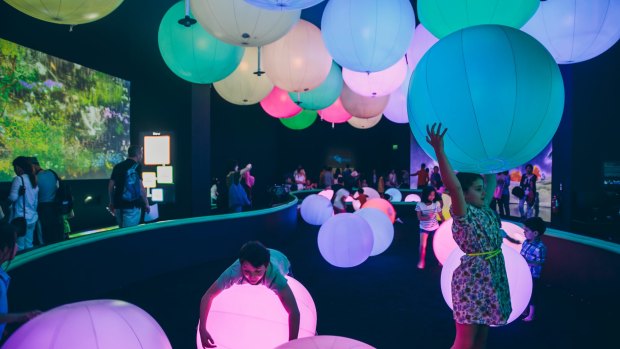
Having a ball at the Arts and Science museum.Credit: Sally Webb
Eating chilli crab in Singapore is arguably more sport than meal, and a fine form of cultural immersion. We have to bib up, get our hands dirty and get physical with the lobster crackers to do justice to the city's most famous dish. My son Archie, 11, does better than me in pulling the crustacean apart to access its sweet flesh, and we mop up the spicy, slightly sweet, tomato sauce, laced with ribbons of beaten egg, with soft bread rolls.
We're at Long Beach Dempsey, one of five Long Beach eateries in Singapore, which have been serving the famed black pepper crab to Singaporeans and visitors alike for years. There are plenty of other restaurants where you can eat a version of chilli crab in Singapore, but this, according to those in the know, is one of the best. It's messy and delicious and satisfying all at the same time, and one of the highlights of our trip.
This isn't our first time in Singapore. On the contrary it's been our preferred family stopover for many years, en route to other parts of the world, but we've never spent more than two days in a row here. I've decided that Singapore deserves a longer trip in its own right, and I've aimed to craft an itinerary that takes in as much of the traditional city, including traditional food, as possible, as well as a few kid-friendly tourist greatest hits.
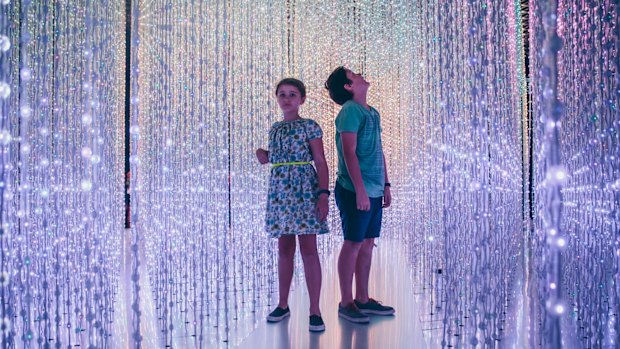
There is much to experience in Singapore.Credit: Sally Webb
A vibrant international metropolis, Singapore also has deeply multicultural roots, with an ethnic makeup consisting of Chinese, Malays, Indians and Eurasians as well as a sizeable expat population. However, it's very easy to come to Singapore and miss its multicultural flavour altogether, experiencing the modern city, eating western food, shopping in global chain stores, staying in international hotels, playing at US-style theme parks on Sentosa and thinking you could be anywhere.
So I entrust our knowledgeable guide, Naseem, with the task of showing us some lesser-visited pockets of the city. First, we get our geographical bearings with a cruise along the Singapore River, in one of the many colourfully painted bumboats, retro fitted with zero emission electric engines, which have plied their trade on these waters for many decades. An onboard audio-visual commentary talks about the evolution of Singapore, its most significant architectural landmarks, and how the city was planned by Sir Stamford Raffles in the early 19th century.
We love exploring Little India and its colourful wet markets selling everything from coconuts to garlands of sweet-smelling flowers. After a trip to India two years earlier Lulu, 9, has bit of a penchant for glittery Indian outfits and the colourful bangles that accessorise them, so she's in heaven (or should that be nirvana?), especially when having her arm hennaed at one of many henna stalls. We also do some deity spotting at Sri Veeramakaliamman Temple, one of Singapore's oldest Hindu shrines.
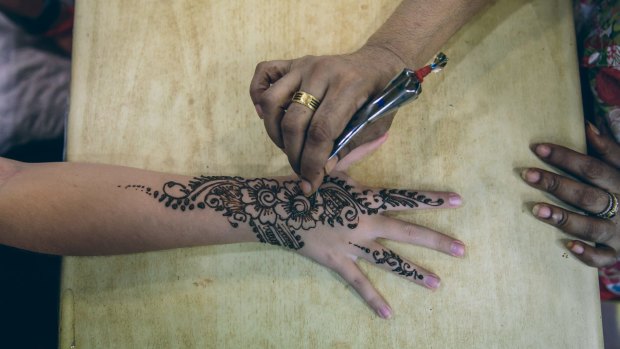
Henna tattoos.
Hinduism gives way to Islam and the Geylang Serai Ramadan Bazaar, a massive food market that pops up every evening during the fasting month. It's the penultimate night of Ramadan and there's an almost frenzied atmosphere, plus huge crowds, and the surrounding streets are festooned with decorative lights.
We also visit Kampong Glam, traditionally the city's Muslim quarter and home to the 200-year-old Masjid Sultan Mosque, which is now regarded as one of Singapore's hippest neighbourhoods. Haji Lane, lined with restored shop-houses and indie boutiques, is one of the few places in Singapore where you'll find street art and murals covering entire buildings. However, the kids are more taken by the "selfie coffees" available from a cafe in the street, that prints your image onto the froth of a cappuccino; so you literally lick your face off.
In Chinatown, we visit the ornate Buddha Tooth Relic temple, which was built in 2007, but looks like it's been in situ for centuries, before tucking into chicken rice, another Singapore culinary classic, in the covered Chinatown Food Street. Afterwards, we browse market stalls with an endless array of tat, peppered between classier shops selling jade, traditional Chinese medicines and tea. We find the perfect souvenirs in Chinese seals, or chops, engraved with the kids' names in both English and Chinese characters. Our visit also includes some of the city's greatest hits, including the multi-award-winning Singapore Zoo, where we tuck into breakfast in the company of a buffoonery of orangutans and the kids handle a python while I move as far away as I can. The zoo's operator, Wildlife Reserves Singapore, runs a cluster of animal-focussed attractions in a single location in the north of the island, including the Night Safari, which we'd visited on our previous stay, and River Safari, and, in a separate location the Jurong Bird Park. It's easy enough to do full immersion animal park – combined tickets to allow you to do it cost-effectively – but for most families one zoo visit each trip is probably enough.
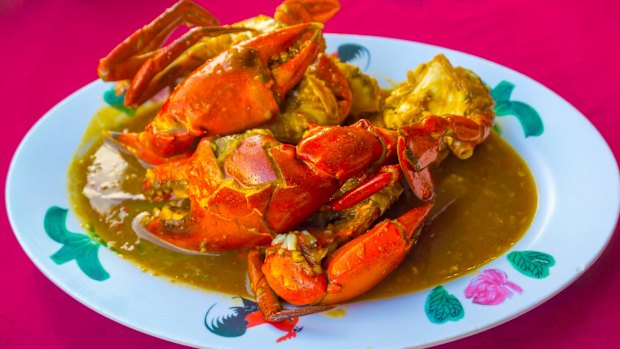
Chilli crab is a Singaporean seafood dish popular in Singapore and Malaysia. Credit: Getty Images
Gardens by the Bay, a nature reserve on reclaimed land near the financial district, is in many ways the quintessence of modern Singapore and reflective of what untrammelled urban vision and deep pockets can create. Two massive greenhouses are at its heart; the Flower Dome mixes permanent botanical displays with a changing floral theme, while the superbly designed Cloud Forest showcases plant life from tropical highlands and features a 35-metre-tall "mountain" covered in lush vegetation, shrouding the world's tallest indoor waterfall. We also witness the mesmerising sound and light show at the Super Tree Grove, a free event that takes place twice a night among the reinforced concrete and metal constructions that rise 16 storeys into the sky and are covered in plants.
I didn't expect to come to Singapore for a nature lesson, but the fragility of the environment and the threats and effects of climate change are themes that resonate throughout our stay, from the zoo to the Cloud Forest and to the Arts Science Museum. The latter, situated inside the striking white lotus-flower-shaped structure on the waterfront at Marina Bay Sands, is a revelation. A permanent exhibition, Future World, by Japanese collective TeamLab makes visitors part of the interactive digital installations, which are a thing of wonder (and in my kids' eyes leave Sydney's Vivid for dead). In the first room, a magical forest created by light, butterflies are projected on to the walls. If you touch them they die and in an intriguing algorithm set by the artist-techno creators they don't return to the environment for ages. In another, the sea rises in front of our eyes and the world as we know it simply disappears. And in another, technology allows us to create and scan drawings that become part of the installation we're viewing. It's simply brilliant.
We split our stay between the financial district and the resort island of Sentosa. It's a good formula for families, as it allows you to experience most of the city's attractions, including events that only happen at night, when based downtown, before going full immersion theme park on Sentosa Island. Once you're on Sentosa – home to the famed S.E.A. Aquarium, Adventure Cove Waterpark and, of course, Universal Studios among other attractions – you'll probably find you can't really be bothered to leave, and the kids probably won't let you.
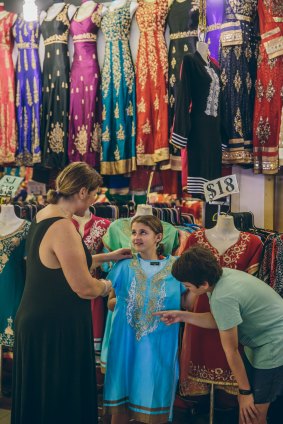
Singapore shopping.
What our short break demonstrates is that Singapore is just as ideal for a first-time-in-Asia experience as it is for a repeat visit, as it can reveal its secrets on many different levels and there's always something new to discover. It is ideal for families, exceptionally safe, clean, efficient and easy to get around. Taxis are plentiful, and there's an efficient MTR system and bus network that will get you to most of the places you'll want to go. Singapore is synonymous with street food, even if the hawkers no longer roam the streets and are instead located in purpose-built centres. One of the best, blending history, Victorian-era architecture and a reputation for the best satay in Singapore, is Lau Pa Sat in the financial district. Boon Tat Street, aka Satay Street, adjacent to the market closes to traffic each night, as vendors set up tables and the diners pile in. It's a frenzied sell of Tiger beer from one vendor, satay from the next, noodles from yet another as each offers their particular fare. Our satays – barbecued morsels of beef, lamb and chicken on skewers, served with a spicy peanut sauce – are simply divine. The initial 10 blow out to triple that number. There's nothing fancy about the food here, which is served on plastic plates – the wet-wipe vendor will find you and you'll need them – but as a Singapore must-do it's at the top of the list.
Not all the food we try is so well-received. At Kopitam Killiney, once a traditional Singaporean coffee shop that now has several outlets throughout the city, we sample a typical Singaporean breakfast of kaya toast with a strangely rich and cloying coconut and egg jam which you then dip into a cold coddled egg. Naseem tells us it's the equivalent of Vegemite on toast for Aussies; I think it's possibly an acquired taste.
Not so chilli crab, which is the hit of the trip, and provides a dose of cultural history too. Created in 1956 by a couple who sold it on the banks of the Kallang River, the dish, is regarded as Singapore's greatest culinary invention. The way I see it, we're tasting history with every mouthful. And I'd return just for that.
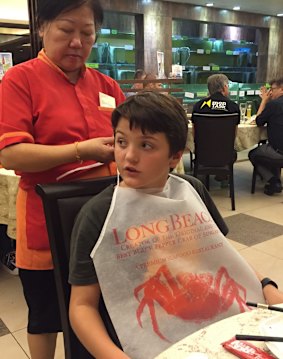
Long beach crab.Credit: Sally Webb
TRIP NOTES
MORE INFORMATION
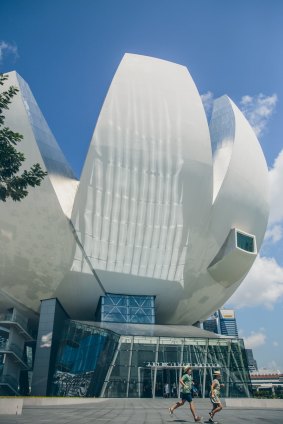
Arts Science Building.Credit: Sally Webb
GETTING THERE
Singapore Airlines has multiple daily flights from both Melbourne and Sydney, as well as from most other state capitals. See singaporeair.com.
STAYING THERE
Located in Marina Bay in the financial district The Westin is a seamless blend of an efficient business hotel with an urban oasis, and boasts arguably the world's best breakfast buffet. Doubles from $S387 ($375). See thewestinsingapore.com.
On Sentosa, the resort-style W hotel at Sentosa Cove has lush grounds, funky decor and a huge pool with floating bean bags and a swim-up bar. Doubles from $S397. See http://www.wsingaporesentosacove.com
Sally Webb travelled courtesy of Singapore Tourism Board.
Sign up for the Traveller Deals newsletter
Get exclusive travel deals delivered straight to your inbox. Sign up now.